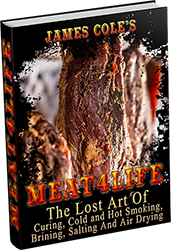Drying and smoking meat are primitive methods of food preservation used by pioneers, early explorers and primitive tribes. Here are four ways to dry and smoke meat for long term food storage. The good news — it’s easier than it looks.Dried meat is a proven and even tasty survival food for surviving a long term food shortage or famine.
Our ancestors lived this earth over many centuries before us, even back when there was no oven, no electric meat dryer, freezer or refrigerator.
They survived despite not having the tools for modern food preservation. The lack of all this comfort we have surrounded ourselves with today didn’t stop them from surviving. They made the best of what little resources they had available at the time. With simple tools like a piece of metal or sharpened wood they were able to hunt animals and preserve meat for extended periods through a process of drying or smoking meat.
Many lived strong, healthy and long lives, even longer than what the life expectancy is nowadays. There were not so many health challenges then; they didn’t have as many diseases, high rates of cancer, diabetes, etc. that are so prevalent today as a result of the modern diet and all it’s processed foods and chemical additives that are harmful to health.
There is just no telling what harmful ingredient some greedy manufacturer might decide to add to his product to save cost — but a lot of them have and continue to do so year after year.
This is why it is worrisome that so many people do not know how to do the simple but necessary task of drying or smoking meat on their own.
4 Simple Ways to Dry and Smoke Meat
Should You Buy Store Bought Jerky?
Have you come to rely on your retail store for your jerky? Realize that you may be paying more money and also getting a food that is highly processed with chemical additives at the same time. For a long term survival food, this is not the best choice for you or your family.
But knowing how to dry and smoke your own cuts of meat could easily be the best choice as a long term survival food.

How many ways do you know to dry meat? If you are like most people, you probably only know one way, and may be unaware that there are other ways to perform the same task faster or better.
Here, you will learn both ancient and modern ways of drying and smoking meat. You may find your favorite method among them, but that shouldn’t stop you from learning a bit about the other methods even if you are pretty sure that one method is all you will ever need.
What happens if a terrorist organization succeeds in taking down the power grid? Transportation and large scale shipping will suddenly ground to a halt with millions of tons of food suddenly stopping en route at what over port or warehouse it is sitting at. Within just days large cities will suddenly run out of food to feed the masses.
Riots, looting, robbery, murder — all over food — will quickly result.
Another possible occurrence is a natural disaster that leaves people stranded with little facilities still functional to live the normal life we have gotten used to.
Depending on where you live, and the degradation of our planet, I believe it is safe to say we have not seen the worst natural disasters yet. How prepared are you for a world without electricity or gasoline? Would you still be able to feed your family if it happens?
Don’t be that person who puts their hope for survival in modern day comfort foods — instead be a leader who knows and is prepared to survive by going back to methods that our ancestors proved worked and even perfected.
Whether a time of feast or famine, you can have the meat resources that many others will lack. You can feed your family for several months ahead.
Read also:
5 TECHNIQUES TO PRESERVE MEAT IN THE WILD YOU SHOULD PRACTICE
Primitive Ways for Smoking Meat
How did our forefathers do it?
The art of smoking meat as a way of preserving it probably started many thousands of years ago. An early tribesman would simply hang out meat to dry. The lack of chimneys in ancient caves and huts often made their shelters smoky. Early people realized soon enough that hanging out meat in such smoky places made meat acquire a different flavor and meat was also preserved for longer periods of time.
tribesman would simply hang out meat to dry. The lack of chimneys in ancient caves and huts often made their shelters smoky. Early people realized soon enough that hanging out meat in such smoky places made meat acquire a different flavor and meat was also preserved for longer periods of time.
Smoking as a way to flavor and dry out meat and extend it’s life became preferred.
Over time, early people also discovered that adding salt (curing) to the meat also increases its shelf life dramatically. Thus curing and smoking became popular and passed on from one civilization to the next.
Types of Meat Smoking
Cold Smoking
When means of transportation began to develop and it didn’t take as long to transport meat from the farmer to the consumers, it became less and less important to preserve meat for long periods. However, smoking is not simply a way to preserve meat; another reason why many people love smoked food is because of the flavor the smoke adds.
Cold smoking is a way to get smoke flavor into the meat without necessarily cooking it.
1. First, the meat is hung up to develop a pellicle.
2. Second, the meat is dehydrated, but not fully, by the smoke. Curing should also accompany the process and the heat should be set at about 20°-30°C, that is 68°-86°F.
Properly prepared dry cure meats can be safely stored at room temperature — see National Center for Home Food Preservation: Smoking and Curing.
Hot Smoking
Just like cold smoking, in hot smoking the meat is also hanged and then smoked. Hanging it makes it develop a pellicle. The main difference between cold and hot smoking is the temperature used when smoking. In hot smoking, the temperature ranges between 52°C and 80°C, that is 126-176°F. Although, hot smoking is generally followed by cooking, hot smoked food are already edible. At that temperature, the meat is cooked, moist, flavored and can be eaten as long as it was smoked evenly.
Smoke Baking/Roasting
This is when you combine smoking with baking or roasting. The optimum temperature of smoke baking/roasting is about 121°C. It can be referred to as barbecuing, pit roasting or pit baking. To smoke your meat this way, you need a smoke roaster. Other things you can use include the barbecue pit, closed wood fire or masonry oven. You could also improvise with other ovens as long as the temperature can get as high as 121°C.
You could also do smoke baking/roasting in your oven. You only have to place a pan filled with hardwood chips beneath the meat in the oven. As the temperature rises, the chips would begin to smolder and the smoke would envelop your meat.
Wherever you choose to do this, always ensure proper ventilation in other to avoid poisoning from carbon monoxide.
Common Types of Smokers
Offset Smoker
This smoker has a cooking chamber and a firebox. The fire is lit in the firebox from where the heat and smoke is channeled to the cooking chamber through connecting pipes. This is how the meat is cooked and flavored by the smoke. This is an exhaust pipe on one end of the cooking chamber to regulate airflow. Most smokers, including large commercial smokers are made from this simple design because of its effectiveness. If you don’t already have an offset smoker, then you may want to get one either for an extended power outage or simply as part of your plan for long term food storage. Take note of step by step guides such as The Complete Book of Butchering, Smoking, Curing, and Sausage Making: How to Harvest Your Livestock & Wild Game.
Many communities have specialized shops that sell smokers though if you shop locally (while good for the shop owner) you may pay more money than from an online retailer (for those of you on a budget consider following the link above to compare prices for smokers online where you may possibly save a hundred dollars or more on the same smoker).
Uptight Drum Smoker
This is an uptight steel drum that has been designed to deliver indirect heat and smoke to your meat. It consists of a drum, a pan to hold charcoal at the floor of the drum, and one or two cooking racks located up the drum. Everything is covered with a veil that leaves some room for proper air flow. Different drum sizes have been used to design this smoker. The possible sizes include 30, 55, and 85 gallon drums. However, the 55 gallon uptight drum smoker is the most popular.
Maximum distance is allowed between the coals and the racks. The distance might be up to 24 inches in order to ensure the meat is not heated directly. To control the heat, you only have to adjust the air intake and exhaust. Aim for equal intake and exhaust for best cooking. You may or may not use a drip pan depending on your flavor preference. This is because the absence of a drip pan gives a unique flavor to the meat that many people love. Expert smokers believe that the dripping moisture should be allowed to drop directly into the fire as this is what gives the true taste of smoked meat.
Vertical Water Smoker
This is different from the Uptight Drum Smoker. The first difference you will notice is its bullet shape. Charcoal or wood is what you need to generate smoke and heat with this bullet smoker. A water bowl separates the fire from the cooking grates. The water has two effects. First, it helps maintain the temperature and humidity in the smoking chamber. And it also adds flavor to the meat when water vapor combines with the smoke. A third purpose for the water bowl is to trap any dripping headed for the fire. This also adds to creating a unique taste.
You may find that you prefer this smoker because it is very easy to use. When the optimal temperature is reached, it is maintained without requiring much adjustment.
Also, they are relatively cheaper.
Propane Smoker
Here, the heat is generated by a gas burner, hence the name propane smoker. The gas burner is placed under the steal which contains charcoal or wood. The environment in the burner is strictly controlled so that there is no oxygen present; this makes the wood or charcoal smoke instead of burning. By design, there would be one or two holes on top of the iron box for proper ventilation. One reason you would enjoy this method is that it does not use as much wood as other smokers.
Smoke Box
This smoker has a “smoke box” and a “fire box”. The smoke box is where the smoke and heat is generated and then channeled into the food box, where the meat is smoked and cooked.
How to Dry Meat in 4 Simple Steps
Preserving meat does not always have to be with an electric dryer or whatever equipment you are used to. What if there is no electricity anymore, would you be able to preserve meat long enough to ensure your survival and that of your family?
Learn how to dry meat, removing all the moisture from it, just the way our forefathers did it.
Do you want to know how to make beef jerky?
Follow this simple procedure to remove moisture and fat from your meat, leaving only protein and limiting fat content to nourish your body.
We will talk about how to cut, trim and debone the carcass of an animal in subsequent articles. That knowledge would be very vital if you are ever in a situation where you have to hunt and kill an animal yourself. For now, lets just assume you have obtained a large chunk of meat that you want to dry using a primitive method.
Step 1: Trim off the fat from the sides of the meat
This will make for more quality and better preservation. When you trim off this fat, you might want to store it somewhere as you may find useful in flavoring other foods, or, for more resourceful people, creating a second survival food called “tallow”.
Step 2: Cut the meat into thin strips along the muscle fibers
This would allow for even drying time of the meat. You should try to make the strips as long as possible. When cutting, please remember that the meat will shrink to up to 70% of its present size; let that guide your decision about what width and length you want your cut strips to be.
Short srips would take more space when hanged to dry, while meat strips that are too long may break because of the weight. Also, thicker slices would require longer drying time because it takes longer for the inner moisture to get to the outer layer where it can drip or evaporate. This is why you should ensure your meat is cut into strips of similar thickness. If they have similar thickness and they are evenly spaced you can expect that they will all get dried at about the same rate of time.
Cutting can be done while the meat is suspended on a hook or on a chopping board, depending on which is preferable or available.
Step 3: Dip the Meat into a Salt Solution
Dipping meat into a salt solution does three things to your meat: It adds to its flavor and taste, it prevents bacterial growth and it also helps to extract moisture from your meat. In addition, it also repels insects that would be attracted to your meat when you start drying it. These insects can cause damage to your meat as they try to feed on its moisture.
But when you have salted the meat strips adequately, you will not have to worry about that.
The salt solution should have about 14% concentration. Just dissolve table salt in warm water and stir. The meat can then be dipped in the solution for 5 minutes before drying.
Step 4: Suspend the Meat to Dry Outdoors
There are a few different ideas on how this can be done.
Metal hooks: You can use metal hooks made out of galvanized wire. Simply cut the wire in a way that it can easily pierce the meat. With the aid of these hooks, you can then suspend your meat strips on a horizontal stick, rope or wire. Ensure that you hook from the heavier/thicker end to ensure stability.
Loops: A thin string or thread is what is needed here. The strings should be divided into 30cm long pieces with knotted ends. You can then attach this string to the thicker end of your strips via double loop. Make the loop firm to ensure balance. You can see here for more details and pictures.
Metal Clips: This is probably the best way to suspend your meat strips. Make sure the metal clips are 4 – 7cm in diameter. You can simply attach the clip to the heavier end of the meat strip and suspend it via your horizontal rope. You can use this for any type of meat strip and be confident that the edges of your meat won’t end up folded or curled when dried.
Note: Do not just place your meat strip over wires, ropes or tree branches. This will not allow for even drying because some parts will get too much sun while other parts are shielded. The meat would also be exposed to dust, rain, storm, insects and even birds and bird dung from tree branches up above.
Instead of just spreading the meat like clothes hung out to dry, set up your own meat drying system with homemade equipment using any of the tools or combination of tools mentioned above.
Also find a way to protect your meat strips from insects, especially if you have a large batch of meat to dry. You may consider investing in an insect screen or sections of mosquito netting carried by online retailers.
Packaging and Storage Dried / Smoked Meat
When you find that your meat is sufficiently dried, and you take it away from the sun, you have to package it properly for preservation. The main aim is to lock out moisture.
To preserve your dried meat, place similar length strips into plastic foils or cellophane. There are other things used for packaging but any of those two should do just fine. You could use transparent cellophane or plastic, that way you can easily observe the quality of your dried meat from time to time.
Now that you’ve learned the steps to drying and smoking meat, practice a few times, and then inspect the quality of your dried meat a few weeks from now and inspect for any signs of spoilage. Remember, if you do this correctly, your dried meat can last several months or even years. Now you know why dried meat (jerky) was a popular staple carried by many early explorers and mountain men in centuries past. This is an essential survival skill to learn and the good news is that you can learn and perfect the skill right at home in your spare time.
You now know how to dry your meat effectively the old school way. You have also seen the different smokers you can use for smoking. Try it out this weekend and let us know in the comments section if you have any questions. You might even inspire further discussions on the subject.
Source: secretsofsurvival.com
Would you like to know how the first settlers preserved their food?
Then you really need this amazing book. It is called The Lost Ways and it contains all the knowledge of our forefathers.
 Here’s just a glimpse of what you’ll find in The Lost Ways:
Here’s just a glimpse of what you’ll find in The Lost Ways:
From Ruff Simons, an old west history expert and former deputy, you’ll learn the techniques and methods used by the wise sheriffs from the frontiers to defend an entire village despite being outnumbered and outgunned by gangs of robbers and bandits, and how you can use their wisdom to defend your home against looters when you’ll be surrounded.
Native American ERIK BAINBRIDGE – who took part in the reconstruction of the native village of Kule Loklo in California, will show you how Native Americans build the subterranean roundhouse, an underground house that today will serve you as a storm shelter, a perfectly camouflaged hideout, or a bunker. It can easily shelter three to four families, so how will you feel if, when all hell breaks loose, you’ll be able to call all your loved ones and offer them guidance and shelter? Besides that, the subterranean roundhouse makes an awesome root cellar where you can keep all your food and water reserves year-round.
From Shannon Azares you’ll learn how sailors from the XVII century preserved water in their ships for months on end, even years and how you can use this method to preserve clean water for your family cost-free.
Mike Searson – who is a Firearm and Old West history expert – will show you what to do when there is no more ammo to be had, how people who wandered the West managed to hunt eight deer with six bullets, and why their supply of ammo never ran out. Remember the panic buying in the first half of 2013? That was nothing compared to what’s going to precede the collapse.
From Susan Morrow, an ex-science teacher and chemist, you’ll master “The Art of Poultice.” She says, “If you really explore the ingredients from which our forefathers made poultices, you’ll be totally surprised by the similarities with modern medicines.” Well…how would you feel in a crisis to be the only one from the group knowledgeable about this lost skill? When there are no more antibiotics, people will turn to you to save their ill children’s lives.
And believe it or not, this is not all…
Table Of Contents:
Making Your Own Beverages: Beer to Stronger Stuff
Ginger Beer: Making Soda the Old Fashioned Way
How North American Indians and Early Pioneers Made Pemmican
Spycraft: Military Correspondence During The 1700’s to 1900’s
Wild West Guns for SHTF and a Guide to Rolling Your Own Ammo
How Our Forefathers Built Their Sawmills, Grain Mills,and Stamping Mills
How Our Ancestors Made Herbal Poultice to Heal Their Wounds
What Our Ancestors Were Foraging For? or How to Wildcraft Your Table
How Our Ancestors Navigated Without Using a GPS System
How Our Forefathers Made Knives
How Our Forefathers Made Snow shoes for Survival
How North California Native Americans Built Their Semi-subterranean Roundhouses
Our Ancestors’Guide to Root Cellars
Good Old Fashioned Cooking on an Open Flame
Learning from Our Ancestors How to Preserve Water
Learning from Our Ancestors How to Take Care of Our Hygiene When There Isn’t Anything to Buy
How and Why I Prefer to Make Soap with Modern Ingredients
Temporarily Installing a Wood-Burning Stove during Emergencies
Making Traditional and Survival Bark Bread…….
Trapping in Winter for Beaver and Muskrat Just like Our Forefathers Did
How to Make a Smokehouse and Smoke Fish
Survival Lessons From The Donner Party
Get your paperback copy HERE
WHAT TO READ NEXT:
5 TECHNIQUES TO PRESERVE MEAT IN THE WILD YOU SHOULD PRACTICE
HOW TO MAKE YOUR OWN BACON (STEP BY STEP GUIDE)
A RETURN TO THE OLD PATHS: HOW TO MAKE PEMMICAN LIKE THE NATIVE AMERICANS
20 LOST RECIPES FROM THE PIONEERS: WHAT THEY COOKED ON THEIR JOURNEY WESTWARD
SEVEN CLASSIC GREAT DEPRESSION ERA RECIPES GRANDMA USED TO MAKE
POTTED MEAT: A LOST SKILL OF LONG TERM MEAT STORAGE
BACK TO BASICS: HOW TO MAKE AND PRESERVE LARD
THE BEST WAY TO STOCKPILE VEGETABLES OFF-GRID
OLD FASHIONED PRESERVING-GRANDPA’S RECIPE FOR CURED SMOKED HAM
HOW TO MAKE GUNPOWDER THE OLD FASHIONED WAY
SURVIVAL HERBAL RECIPES FROM OUR ANCESTORS
HOW TO PRESERVE MEAT FOR SURVIVAL LIKE OUR GRANDFATHERS
OTHER USEFUL RESOURCES:
The 3 Pioneer Survival Lessons We Should Learn
The Most Effective Home Defense Strategies
Old School Hacks for Off-Grid Living
The Medical Emergency Crash Course


Expert share!
Really very helpful tips. Your “Do you want to know how to make beef jerky?” part help me a lot to know about how to make beef jerky
Why does purchased beef jerky have to be refrigerated?